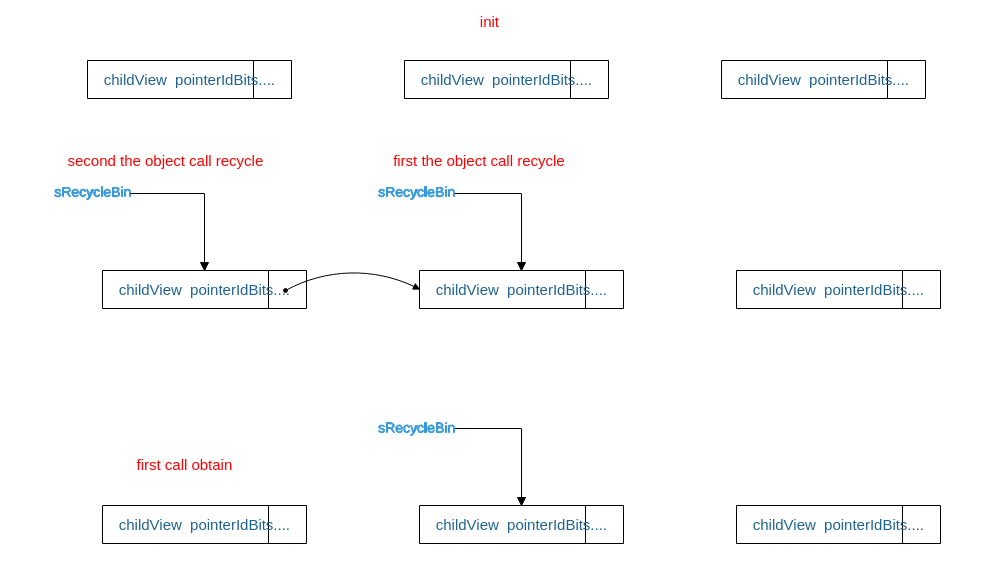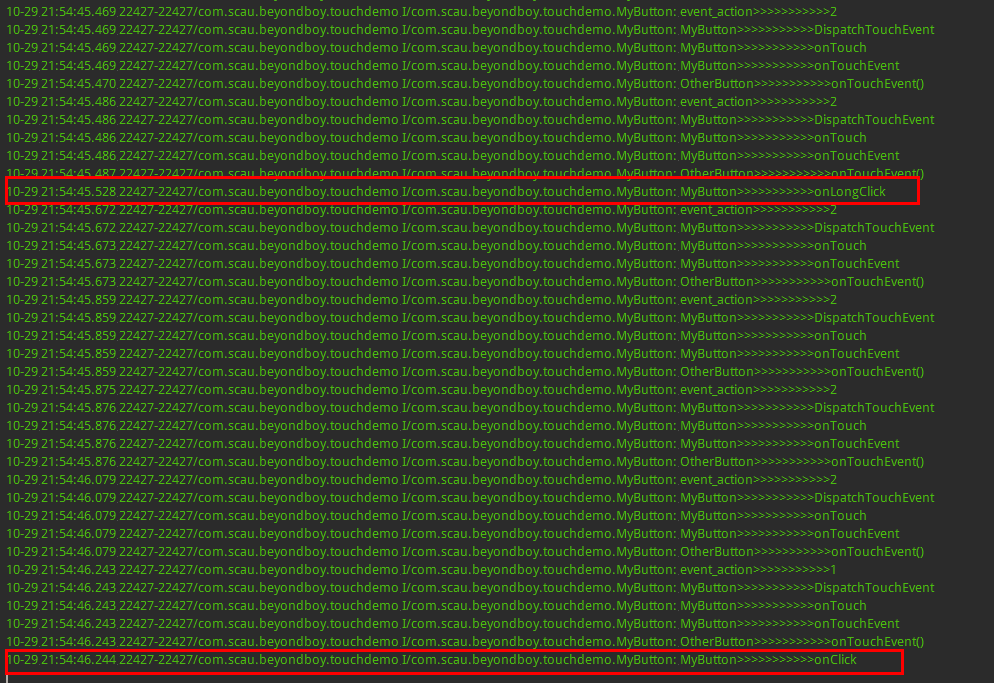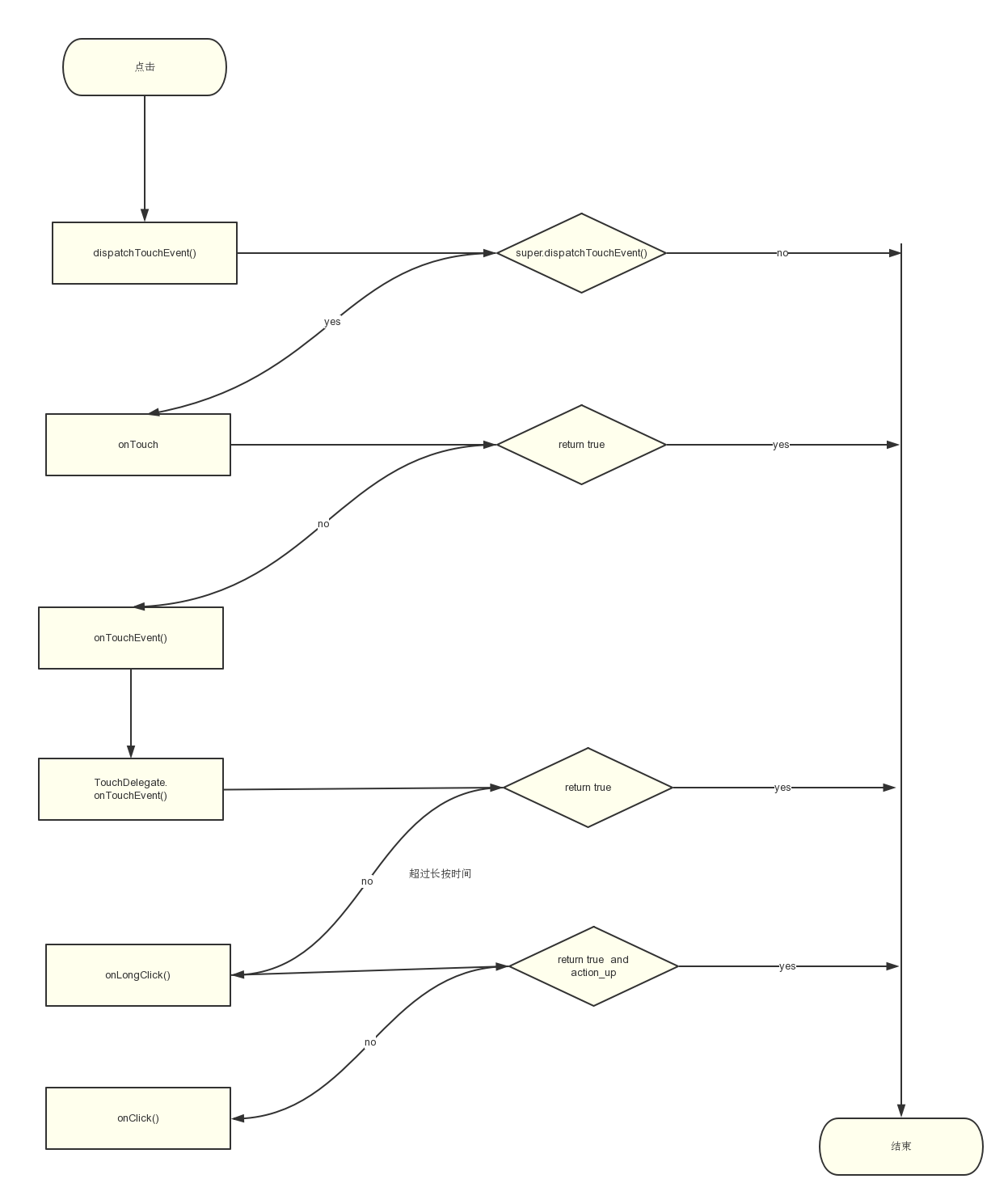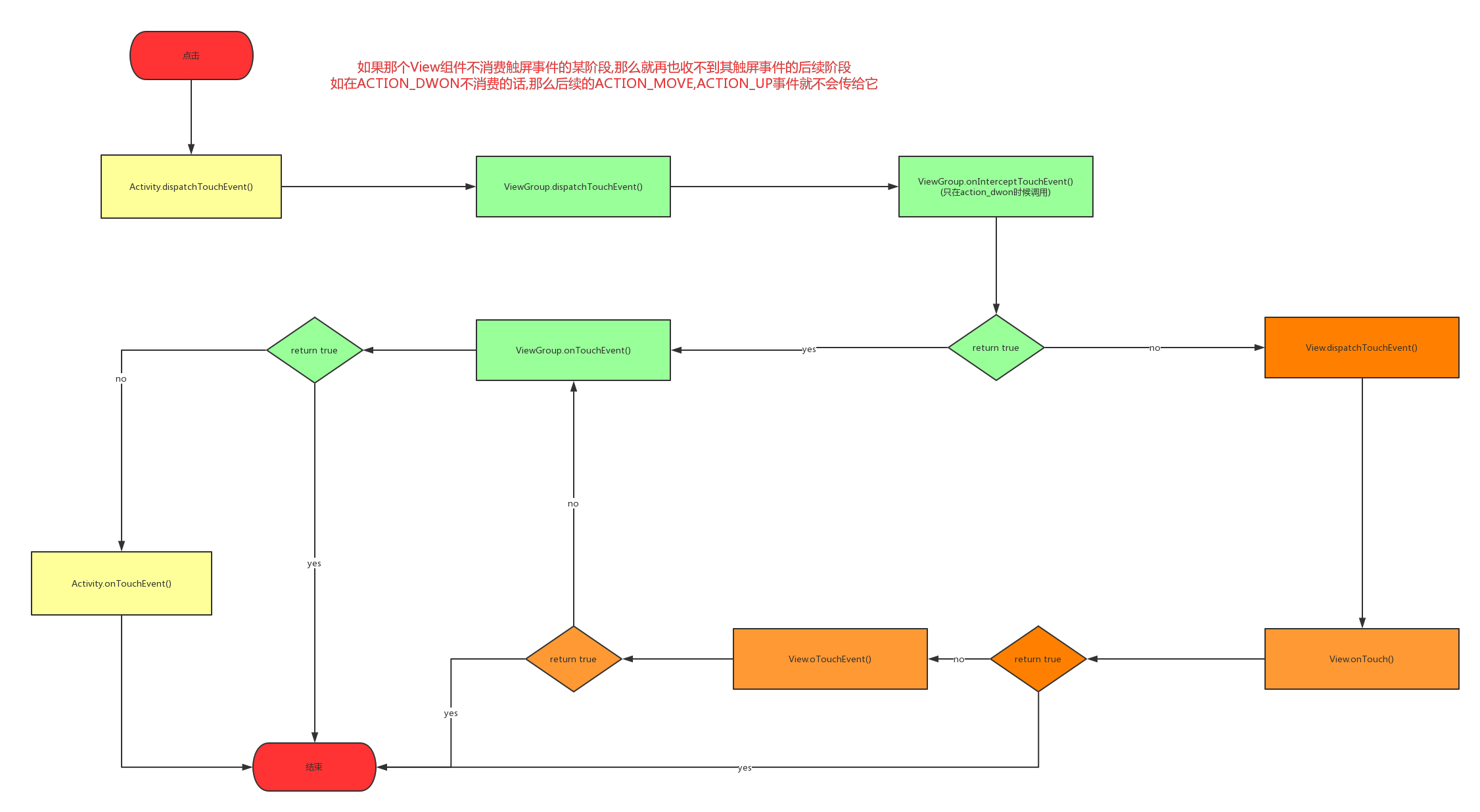在android触屏事件中,我们经常会碰到onclick(),onTouch(),onTouchEven()等方法,那谁会先执行,执行顺序又是怎么样呢?
View的触屏事件处理
为弄清除上面那些,首先从源码入手,看看其整个触屏事件分发的过程.
先从dispatchTouchEvent()分析:
/**
* Pass the touch screen motion event down to the target view, or this
* view if it is the target.
*
* @param event The motion event to be dispatched.
* @return True if the event was handled by the view, false otherwise.
*/
public boolean dispatchTouchEvent(MotionEvent event) {
// If the event should be handled by accessibility focus first.
if (event.isTargetAccessibilityFocus()) {
// We don't have focus or no virtual descendant has it, do not handle the event.
if (!isAccessibilityFocusedViewOrHost()) {
return false;
}
// We have focus and got the event, then use normal event dispatch.
event.setTargetAccessibilityFocus(false);
}
boolean result = false;
if (mInputEventConsistencyVerifier != null) {
mInputEventConsistencyVerifier.onTouchEvent(event, 0);
}
final int actionMasked = event.getActionMasked();
if (actionMasked == MotionEvent.ACTION_DOWN) {
// Defensive cleanup for new gesture
stopNestedScroll();
}
if (onFilterTouchEventForSecurity(event)) {
//noinspection SimplifiableIfStatement
ListenerInfo li = mListenerInfo;
if (li != null && li.mOnTouchListener != null
&& (mViewFlags & ENABLED_MASK) == ENABLED
&& li.mOnTouchListener.onTouch(this, event)) {
result = true;
}
if (!result && onTouchEvent(event)) {
result = true;
}
}
if (!result && mInputEventConsistencyVerifier != null) {
mInputEventConsistencyVerifier.onUnhandledEvent(event, 0);
}
// Clean up after nested scrolls if this is the end of a gesture;
// also cancel it if we tried an ACTION_DOWN but we didn't want the rest
// of the gesture.
if (actionMasked == MotionEvent.ACTION_UP ||
actionMasked == MotionEvent.ACTION_CANCEL ||
(actionMasked == MotionEvent.ACTION_DOWN && !result)) {
stopNestedScroll();
}
return result;
}分析这段源码,便知道有些细节地方,如果目标View不能获取焦点,那么就不会处理触屏事件,而是直接返回false ,否则判断目标View是否满足注册了onTouchListener()监听以及可点击的条件,满足则会调用onTouch(),如果onTouch()返回true,那么就不会再执行onTouchEvent()了,如果前面onTouch()返回了false,那么就会由onTouchEvent()的返回值来确定最终的结果值了,因此遵从onTouch()==true? true:onTouchEvent()规则.在这段源码中,可以看出其执行顺序的优先级是dispatchOnTouchEvent()>>>>onTouch()>>>>onTouchEvent().
再来看看onTouchEvent()在View.java源码中有的实现:
/**
* Implement this method to handle touch screen motion events.
* <p>
* If this method is used to detect click actions, it is recommended that
* the actions be performed by implementing and calling
* {@link #performClick()}. This will ensure consistent system behavior,
* including:
* <ul>
* <li>obeying click sound preferences
* <li>dispatching OnClickListener calls
* <li>handling {@link AccessibilityNodeInfo#ACTION_CLICK ACTION_CLICK} when
* accessibility features are enabled
* </ul>
*
* @param event The motion event.
* @return True if the event was handled, false otherwise.
*/
public boolean onTouchEvent(MotionEvent event) {
final float x = event.getX();
final float y = event.getY();
final int viewFlags = mViewFlags;
final int action = event.getAction();
if ((viewFlags & ENABLED_MASK) == DISABLED) {
if (action == MotionEvent.ACTION_UP && (mPrivateFlags & PFLAG_PRESSED) != 0) {
setPressed(false);
}
// A disabled view that is clickable still consumes the touch
// events, it just doesn't respond to them.
return (((viewFlags & CLICKABLE) == CLICKABLE
|| (viewFlags & LONG_CLICKABLE) == LONG_CLICKABLE)
|| (viewFlags & CONTEXT_CLICKABLE) == CONTEXT_CLICKABLE);
}
if (mTouchDelegate != null) {
if (mTouchDelegate.onTouchEvent(event)) {
return true;
}
}
if (((viewFlags & CLICKABLE) == CLICKABLE ||
(viewFlags & LONG_CLICKABLE) == LONG_CLICKABLE) ||
(viewFlags & CONTEXT_CLICKABLE) == CONTEXT_CLICKABLE) {
switch (action) {
case MotionEvent.ACTION_UP:
boolean prepressed = (mPrivateFlags & PFLAG_PREPRESSED) != 0;
if ((mPrivateFlags & PFLAG_PRESSED) != 0 || prepressed) {
// take focus if we don't have it already and we should in
// touch mode.
boolean focusTaken = false;
if (isFocusable() && isFocusableInTouchMode() && !isFocused()) {
focusTaken = requestFocus();
}
if (prepressed) {
// The button is being released before we actually
// showed it as pressed. Make it show the pressed
// state now (before scheduling the click) to ensure
// the user sees it.
setPressed(true, x, y);
}
//如果onLongClick()返回true,就不会执行onClick()
if (!mHasPerformedLongPress && !mIgnoreNextUpEvent) {
// This is a tap, so remove the longpress check
removeLongPressCallback();
// Only perform take click actions if we were in the pressed state
if (!focusTaken) {
// Use a Runnable and post this rather than calling
// performClick directly. This lets other visual state
// of the view update before click actions start.
if (mPerformClick == null) {
mPerformClick = new PerformClick();
}
if (!post(mPerformClick)) {
performClick();
}
}
}
if (mUnsetPressedState == null) {
mUnsetPressedState = new UnsetPressedState();
}
if (prepressed) {
postDelayed(mUnsetPressedState,
ViewConfiguration.getPressedStateDuration());
} else if (!post(mUnsetPressedState)) {
// If the post failed, unpress right now
mUnsetPressedState.run();
}
removeTapCallback();
}
mIgnoreNextUpEvent = false;
break;
case MotionEvent.ACTION_DOWN:
mHasPerformedLongPress = false;
if (performButtonActionOnTouchDown(event)) {
break;
}
// Walk up the hierarchy to determine if we're inside a scrolling container.
boolean isInScrollingContainer = isInScrollingContainer();
// For views inside a scrolling container, delay the pressed feedback for
// a short period in case this is a scroll.
if (isInScrollingContainer) {
mPrivateFlags |= PFLAG_PREPRESSED;
if (mPendingCheckForTap == null) {
mPendingCheckForTap = new CheckForTap();
}
mPendingCheckForTap.x = event.getX();
mPendingCheckForTap.y = event.getY();
postDelayed(mPendingCheckForTap, ViewConfiguration.getTapTimeout());
} else {
// Not inside a scrolling container, so show the feedback right away
setPressed(true, x, y);
checkForLongClick(0);
}
break;
case MotionEvent.ACTION_CANCEL:
setPressed(false);
removeTapCallback();
removeLongPressCallback();
mInContextButtonPress = false;
mHasPerformedLongPress = false;
mIgnoreNextUpEvent = false;
break;
case MotionEvent.ACTION_MOVE:
drawableHotspotChanged(x, y);
// Be lenient about moving outside of buttons
if (!pointInView(x, y, mTouchSlop)) {
// Outside button
removeTapCallback();
if ((mPrivateFlags & PFLAG_PRESSED) != 0) {
// Remove any future long press/tap checks
removeLongPressCallback();
setPressed(false);
}
}
break;
}
return true;
}
return false;
}
private void checkForLongClick(int delayOffset) {
if ((mViewFlags & LONG_CLICKABLE) == LONG_CLICKABLE) {
mHasPerformedLongPress = false;
if (mPendingCheckForLongPress == null) {
mPendingCheckForLongPress = new CheckForLongPress();
}
mPendingCheckForLongPress.rememberWindowAttachCount();
postDelayed(mPendingCheckForLongPress,
ViewConfiguration.getLongPressTimeout() - delayOffset);
}
}
private final class CheckForTap implements Runnable {
public float x;
public float y;
@Override
public void run() {
mPrivateFlags &= ~PFLAG_PREPRESSED;
setPressed(true, x, y);
checkForLongClick(ViewConfiguration.getTapTimeout());
}
}
private final class CheckForLongPress implements Runnable {
private int mOriginalWindowAttachCount;
@Override
public void run() {
if (isPressed() && (mParent != null)
&& mOriginalWindowAttachCount == mWindowAttachCount) {
//返回true的话,就不执行onclick()
if (performLongClick()) {
mHasPerformedLongPress = true;
}
}
}
public void rememberWindowAttachCount() {
mOriginalWindowAttachCount = mWindowAttachCount;
}
}
private final class PerformClick implements Runnable {
@Override
public void run() {
performClick();
}
}这段代码稍微多一点,但也有好多细节要注意的,如果有目标View有传入过TouchDelegate对象,那么一切来到这里的触屏事件都会交给其TouchDelegate.onTouchEvent()处理并返回true,在ACTION_DOWN阶段中,如果顶层容器不是滚动类的容器,那么直接通知目标View转变按压视图状态,并且开始通过postDelayed()来设置CheckForLongPress()对象,一旦长按时间超过了ViewConfiguration.getLongPressTimeout(),CheckForLongPress()对象就会执行对应长按回调方法,如果顶层容器是滚动类的容器,那么会通过postDelayed()传入CheckForTap()对象,直到ViewConfiguration.getTapTimeout()时候才让View转变按压视图状态,而不是立刻改变,同时CheckForTap()对象也创建对应CheckForLongPress()对象.同时还带有prepressed时期标记,在ACTION_UP阶段中,如果目标View没有长按(既不会执行CheckForLongPress()对象里的方法),同时不能获取到焦点并返回false,那么便会执行PerformClick()对应方法,从而调用OnClickListener.onclick(),还有最后一点的细节就是,如果目标View满足CLICKABLE,LONG_CLICKABLE,CONTEXT_CLICKABLE其中一个条件,那么onTouchEvent()就会返回true.在经过一些列的分析,可以看出其执行的顺序优先级:`onTouchEvent()>>>>TouchDelegate.onTouchEvent()>>>>onLongClick()>>>>onClick().
ViewGroup的触屏分发实现
上面的那段是基于View.java源码分析,那么来分析一下其ViewGroup.java源码,看看其又是如何分发触屏事件的.
/**
* Transforms a motion event into the coordinate space of a particular child view,
* filters out irrelevant pointer ids, and overrides its action if necessary.
* If child is null, assumes the MotionEvent will be sent to this ViewGroup instead.
*/
//用来派发给子View触屏事件
private boolean dispatchTransformedTouchEvent(MotionEvent event, boolean cancel,
View child, int desiredPointerIdBits) {
final boolean handled;
// Canceling motions is a special case. We don't need to perform any transformations
// or filtering. The important part is the action, not the contents.
final int oldAction = event.getAction();
if (cancel || oldAction == MotionEvent.ACTION_CANCEL) {
event.setAction(MotionEvent.ACTION_CANCEL);
//如果child为空,则会回调父类的dispatchTouchEvent()
if (child == null) {
handled = super.dispatchTouchEvent(event);
} else {
handled = child.dispatchTouchEvent(event);
}
event.setAction(oldAction);
return handled;
}
// Calculate the number of pointers to deliver.
final int oldPointerIdBits = event.getPointerIdBits();
final int newPointerIdBits = oldPointerIdBits & desiredPointerIdBits;
// If for some reason we ended up in an inconsistent state where it looks like we
// might produce a motion event with no pointers in it, then drop the event.
if (newPointerIdBits == 0) {
return false;
}
// If the number of pointers is the same and we don't need to perform any fancy
// irreversible transformations, then we can reuse the motion event for this
// dispatch as long as we are careful to revert any changes we make.
// Otherwise we need to make a copy.
final MotionEvent transformedEvent;
if (newPointerIdBits == oldPointerIdBits) {
if (child == null || child.hasIdentityMatrix()) {
if (child == null) {
handled = super.dispatchTouchEvent(event);
} else {
//如果触屏事件设置偏移量以和支持单位矩阵变换的子view一致
//如子View做一些平移等动画操作时的点击
final float offsetX = mScrollX - child.mLeft;
final float offsetY = mScrollY - child.mTop;
event.offsetLocation(offsetX, offsetY);
handled = child.dispatchTouchEvent(event);
event.offsetLocation(-offsetX, -offsetY);
}
return handled;
}
transformedEvent = MotionEvent.obtain(event);
} else {
transformedEvent = event.split(newPointerIdBits);
}
// Perform any necessary transformations and dispatch.
if (child == null) {
handled = super.dispatchTouchEvent(transformedEvent);
} else {
final float offsetX = mScrollX - child.mLeft;
final float offsetY = mScrollY - child.mTop;
transformedEvent.offsetLocation(offsetX, offsetY);
if (! child.hasIdentityMatrix()) {
//恢复原来触屏事件发生坐标,即相当于撤销了offsetLocation()作用
transformedEvent.transform(child.getInverseMatrix());
}
handled = child.dispatchTouchEvent(transformedEvent);
}
// Done.
transformedEvent.recycle();
return handled;
}在触屏事件分发给子View的逻辑中可以知道一个细节,如果child为空,那么会回调父类的dispatchTouchEvent()方法,否则就调用子View的dispatchTouchEvent(),执行顺序的优先级:当前ViewGroup的dispatchTouchEvent()>>>>>childView!=null?dispatchTouchEvent():super.dispatchTouchEvent().
/* Describes a touched view and the ids of the pointers that it has captured.
*
* This code assumes that pointer ids are always in the range 0..31 such that
* it can use a bitfield to track which pointer ids are present.
* As it happens, the lower layers of the input dispatch pipeline also use the
* same trick so the assumption should be safe here...
*/
private static final class TouchTarget {
private static final int MAX_RECYCLED = 32;
private static final Object sRecycleLock = new Object[0];
private static TouchTarget sRecycleBin;
private static int sRecycledCount;
public static final int ALL_POINTER_IDS = -1; // all ones
// The touched child view.
public View child;
// The combined bit mask of pointer ids for all pointers captured by the target.
public int pointerIdBits;//通过位标记来记录节点在链表的位置
// The next target in the target list.
public TouchTarget next;
private TouchTarget() {
}
public static TouchTarget obtain(View child, int pointerIdBits) {
final TouchTarget target;
synchronized (sRecycleLock) {
if (sRecycleBin == null) {
target = new TouchTarget();
} else {
target = sRecycleBin;
sRecycleBin = target.next;
sRecycledCount--;
target.next = null;
}
}
target.child = child;
target.pointerIdBits = pointerIdBits;
return target;
}
public void recycle() {
synchronized (sRecycleLock) {
if (sRecycledCount < MAX_RECYCLED) {
next = sRecycleBin;
sRecycleBin = this;
sRecycledCount += 1;
} else {
next = null;
}
child = null;
}
}
}通过链表方式来维护触屏事件的,但在这里有个很巧妙的地方,也通过sRecycleBin指针来复用对象,很多地方都用类似的技巧来复用对象,如listView创建item对象,具体过程如图所示(假设初始化时,不串联对象):

在dispatchTouchEvent()方法中,由于这段代码还比较长,很多细节,因此我把代码分成两个阶段去分析.
//第一阶段 拦截事件时,触屏事件的分发处理
//即某段时刻intercepted会返回true.
/**
* {@inheritDoc}
*/
@Override
public boolean dispatchTouchEvent(MotionEvent ev) {
if (mInputEventConsistencyVerifier != null) {
mInputEventConsistencyVerifier.onTouchEvent(ev, 1);
}
// If the event targets the accessibility focused view and this is it, start
// normal event dispatch. Maybe a descendant is what will handle the click.
if (ev.isTargetAccessibilityFocus() && isAccessibilityFocusedViewOrHost()) {
ev.setTargetAccessibilityFocus(false);
}
boolean handled = false;
if (onFilterTouchEventForSecurity(ev)) {
final int action = ev.getAction();
final int actionMasked = action & MotionEvent.ACTION_MASK;
// Handle an initial down.
if (actionMasked == MotionEvent.ACTION_DOWN) {
// Throw away all previous state when starting a new touch gesture.
// The framework may have dropped the up or cancel event for the previous gesture
// 在ACTION_DOWN会丢弃以前的触屏事件和清除触屏状态
cancelAndClearTouchTargets(ev);
resetTouchState();
}
// Check for interception.
final boolean intercepted;
//在ACTION_DOWN时候会执行或有目标子View的时候
//如果没有找到处理触屏事件的View那么其他的
//后续触屏事件会被当前的容器拦截,不再分发给子View
if (actionMasked == MotionEvent.ACTION_DOWN
|| mFirstTouchTarget != null) {
final boolean disallowIntercept = (mGroupFlags & FLAG_DISALLOW_INTERCEPT) != 0;
if (!disallowIntercept) {
intercepted = onInterceptTouchEvent(ev);
ev.setAction(action); // restore action in case it was changed
} else {
intercepted = false;
}
} else {
// There are no touch targets and this action is not an initial down
// so this view group continues to intercept touches.
intercepted = true;
}
// If intercepted, start normal event dispatch. Also if there is already
// a view that is handling the gesture, do normal event dispatch.
if (intercepted || mFirstTouchTarget != null) {
ev.setTargetAccessibilityFocus(false);
}
// Check for cancelation.
final boolean canceled = resetCancelNextUpFlag(this)
|| actionMasked == MotionEvent.ACTION_CANCEL;
// Update list of touch targets for pointer down, if needed.
final boolean split = (mGroupFlags & FLAG_SPLIT_MOTION_EVENTS) != 0;
TouchTarget newTouchTarget = null;
boolean alreadyDispatchedToNewTouchTarget = false;
if (!canceled && !intercepted){
//省略另一阶段的代码.............................
}
// Dispatch to touch targets.
//拦截事件且没有子View处理触屏事件的时候,即回调父类的dispatchTransformedTouchEvent()
if (mFirstTouchTarget == null) {
// No touch targets so treat this as an ordinary view.
handled = dispatchTransformedTouchEvent(ev, canceled, null,
TouchTarget.ALL_POINTER_IDS);
} else {
// Dispatch to touch targets, excluding the new touch target if we already
// dispatched to it. Cancel touch targets if necessary.
//会把在拦截事件前所捕获到的触屏事件交给子View去处理,拦截事件后的触屏事件交给自己去
处理
TouchTarget predecessor = null;//前个触屏事件节点
TouchTarget target = mFirstTouchTarget;//当前触屏事件节点
while (target != null) {
final TouchTarget next = target.next;
if (alreadyDispatchedToNewTouchTarget && target == newTouchTarget) {
handled = true;
} else {
//派发拦截事件前的触屏事件给子View,如果拦截(intercepted==true)
//则触屏事件交给父类dispatchOnTouchEvent()
final boolean cancelChild = resetCancelNextUpFlag(target.child)
|| intercepted;
if (dispatchTransformedTouchEvent(ev, cancelChild,
target.child, target.pointerIdBits)) {
handled = true;
}
if (cancelChild) {
if (predecessor == null) {
mFirstTouchTarget = next;
} else {
predecessor.next = next;
}
target.recycle();
target = next;
continue;
}
}
predecessor = target;
target = next;
}
}
// Update list of touch targets for pointer up or cancel, if needed.
if (canceled
|| actionMasked == MotionEvent.ACTION_UP
|| actionMasked == MotionEvent.ACTION_HOVER_MOVE) {
//清除触屏事件状态
resetTouchState();
} else if (split && actionMasked == MotionEvent.ACTION_POINTER_UP) {
final int actionIndex = ev.getActionIndex();
final int idBitsToRemove = 1 << ev.getPointerId(actionIndex);
removePointersFromTouchTargets(idBitsToRemove);
}
}
if (!handled && mInputEventConsistencyVerifier != null) {
mInputEventConsistencyVerifier.onUnhandledEvent(ev, 1);
}
return handled;
}在分析上面第一阶段时,注意到一些细节处理,如果ViewGroup没有嵌套子View的话,那么就会回调父类的dispatchTouchEvent(),但如果ViewGroup有嵌套子View,但没有一开始拦截的话,那就会将拦截前的触屏事件交给子ViewdispatchTouchEvent()去处理,拦截后的触屏事件交给父类的dispatchTouchEvent()去处理.还有一点就是如果某个子View在dispatchTouchEvent()和onTouch()和onTouchEvent()都不处理触屏事件ACTION_DOWN或ACTON_MOVE等阶段,即都返回false,那子View就再也接受不到触屏事件的后续阶段了(如ACTION_UP).
//第二阶段不拦截触屏事件
/**
* {@inheritDoc}
*/
@Override
public boolean dispatchTouchEvent(MotionEvent ev) {
//省略代码............................................
if (!canceled && !intercepted) {
// If the event is targeting accessiiblity focus we give it to the
// view that has accessibility focus and if it does not handle it
// we clear the flag and dispatch the event to all children as usual.
// We are looking up the accessibility focused host to avoid keeping
// state since these events are very rare.
View childWithAccessibilityFocus = ev.isTargetAccessibilityFocus()
? findChildWithAccessibilityFocus() : null;
if (actionMasked == MotionEvent.ACTION_DOWN
|| (split && actionMasked == MotionEvent.ACTION_POINTER_DOWN)
|| actionMasked == MotionEvent.ACTION_HOVER_MOVE) {
final int actionIndex = ev.getActionIndex(); // always 0 for down
final int idBitsToAssign = split ? 1 << ev.getPointerId(actionIndex)
: TouchTarget.ALL_POINTER_IDS;
// Clean up earlier touch targets for this pointer id in case they
// have become out of sync.
removePointersFromTouchTargets(idBitsToAssign);
final int childrenCount = mChildrenCount;
if (newTouchTarget == null && childrenCount != 0) {
final float x = ev.getX(actionIndex);
final float y = ev.getY(actionIndex);
// Find a child that can receive the event.
// Scan children from front to back.
final ArrayList<View> preorderedList = buildOrderedChildList();
final boolean customOrder = preorderedList == null
&& isChildrenDrawingOrderEnabled();
final View[] children = mChildren;
for (int i = childrenCount - 1; i >= 0; i--) {
final int childIndex = customOrder
? getChildDrawingOrder(childrenCount, i) : i;
final View child = (preorderedList == null)
? children[childIndex] : preorderedList.get(childIndex);
// If there is a view that has accessibility focus we want it
// to get the event first and if not handled we will perform a
// normal dispatch. We may do a double iteration but this is
// safer given the timeframe.
if (childWithAccessibilityFocus != null) {
if (childWithAccessibilityFocus != child) {
continue;
}
childWithAccessibilityFocus = null;
i = childrenCount - 1;
}
if (!canViewReceivePointerEvents(child)
|| !isTransformedTouchPointInView(x, y, child, null)) {
ev.setTargetAccessibilityFocus(false);
continue;
}
newTouchTarget = getTouchTarget(child);
if (newTouchTarget != null) {
// Child is already receiving touch within its bounds.
// Give it the new pointer in addition to the ones it is handling.
newTouchTarget.pointerIdBits |= idBitsToAssign;
break;
}
resetCancelNextUpFlag(child);
if (dispatchTransformedTouchEvent(ev, false, child, idBitsToAssign)) {
// Child wants to receive touch within its bounds.
mLastTouchDownTime = ev.getDownTime();
if (preorderedList != null) {
// childIndex points into presorted list, find original index
for (int j = 0; j < childrenCount; j++) {
if (children[childIndex] == mChildren[j]) {
mLastTouchDownIndex = j;
break;
}
}
} else {
mLastTouchDownIndex = childIndex;
}
mLastTouchDownX = ev.getX();
mLastTouchDownY = ev.getY();
newTouchTarget = addTouchTarget(child, idBitsToAssign);
alreadyDispatchedToNewTouchTarget = true;
break;
}
// The accessibility focus didn't handle the event, so clear
// the flag and do a normal dispatch to all children.
ev.setTargetAccessibilityFocus(false);
}
if (preorderedList != null) preorderedList.clear();
}
if (newTouchTarget == null && mFirstTouchTarget != null) {
// Did not find a child to receive the event.
// Assign the pointer to the least recently added target.
newTouchTarget = mFirstTouchTarget;
while (newTouchTarget.next != null) {
newTouchTarget = newTouchTarget.next;
}
newTouchTarget.pointerIdBits |= idBitsToAssign;
}
}
}
//省略代码.........................................................
return handled;
}这段代码主要处理ACTION_DOWN阶段,只在ACTION_DOWN阶段仅一次或0次调用onInterceptTouchEvent()来决定要不要拦截触屏事件,如果不拦截,那就找消费触屏事件的子View,即子View处理触屏事件的最终结果返回true,然后做一些记录操,最后用链表串联触屏对象.在结合第一段阶段的代码,可以看出其触屏事件执行顺序的优先级:当前容器的dispatchTouchEvent()>>>>>onInterceptTouchEvent()>>>>>childView!=null?dispatchTouchEvent():super.dispatchTouchEvent().
触屏事件处理DEMO
上面围绕一大堆源码分析后,可能很容易被搞混,为印象更加深刻,基于上面理论实践一个demo来验证,并画出对应的处理流程图.
public class MyButton extends Button implements View.OnClickListener,View.OnTouchListener,View.OnLongClickListener{
private static final String TAG = MyButton.class.getName();
public MyButton(Context context, AttributeSet attrs) {
super(context, attrs);
setOnClickListener(this);
setOnTouchListener(this);
setOnLongClickListener(this);
Button button=new Button(context){
@Override
public boolean onTouchEvent(MotionEvent event) {
Log.i(TAG,"OtherButton>>>>>>>>>>>onTouchEvent()");
return true;
}
};
DisplayMetrics displayMetrics=context.getResources().getDisplayMetrics();
setTouchDelegate(new TouchDelegate(new Rect(0,0,displayMetrics.widthPixels,displayMetrics.heightPixels),button));
}
@Override
public boolean onLongClick(View view) {
Log.i(TAG,"MyButton>>>>>>>>>>>onLongClick");
return false;
}
@Override
public boolean onTouch(View view, MotionEvent motionEvent) {
Log.i(TAG,"MyButton>>>>>>>>>>>onTouch");
return false;
}
@Override
public void onClick(View view) {
Log.i(TAG,"MyButton>>>>>>>>>>>onClick");
}
@Override
public boolean onTouchEvent(MotionEvent event) {
Log.i(TAG,"MyButton>>>>>>>>>>>onTouchEvent");
return super.onTouchEvent(event);
}
@Override
public boolean dispatchTouchEvent(MotionEvent event) {
Log.i(TAG,"event_action>>>>>>>>>>>"+event.getAction());
Log.i(TAG,"MyButton>>>>>>>>>>>DispatchTouchEvent");
return super.dispatchTouchEvent(event);
}
}
将代理的button的onTouch()返回false.其短按和长按事件处理流程如图:
短按:

长按:

对于View处理触屏事件的其他的情况,我就不再一一测试了,总的来说,View处理触屏事件流程就如图所示:
//子布局
public class MyButton extends Button implements View.OnClickListener, View.OnTouchListener, View.OnLongClickListener {
private static final String TAG = MyButton.class.getName();
public MyButton(Context context, AttributeSet attrs) {
super(context, attrs);
}
@Override
public boolean dispatchTouchEvent(MotionEvent event) {
switch (event.getAction()){
case MotionEvent.ACTION_DOWN:
Log.i(TAG, "ACTION_DOWN>>>>>>>>>>>DispatchTouchEvent");
break;
case MotionEvent.ACTION_MOVE:
Log.i(TAG, "ACTION_MOVE>>>>>>>>>>>DispatchTouchEvent");
break;
case MotionEvent.ACTION_UP:
Log.i(TAG, "ACTION_UP>>>>>>>>>>>DispatchTouchEvent");
break;
}
return false;
}
}
//父布局,该布局会嵌套MyButton
public class MyRelativeLayout extends RelativeLayout {
private static final String TAG = MyRelativeLayout.class.getName();
public MyRelativeLayout(Context context, AttributeSet attrs) {
super(context, attrs);
//setClickable(true);
}
@Override
public boolean dispatchTouchEvent(MotionEvent event) {
switch (event.getAction()){
case MotionEvent.ACTION_DOWN:
Log.i(TAG, "ACTION_DOWN>>>>>>>>>>>dispatchTouchEvent");
break;
case MotionEvent.ACTION_MOVE:
Log.i(TAG, "ACTION_MOVE>>>>>>>>>>>dispatchTouchEvent");
break;
case MotionEvent.ACTION_UP:
Log.i(TAG, "ACTION_UP>>>>>>>>>>>dispatchTouchEvent");
break;
}
return super.dispatchTouchEvent(event);
}
@Override
public boolean onInterceptTouchEvent(MotionEvent ev) {
switch (ev.getAction()){
case MotionEvent.ACTION_DOWN:
Log.i(TAG, "ACTION_DOWN>>>>>>>>>>>onInterceptTouchEvent");
break;
case MotionEvent.ACTION_MOVE:
Log.i(TAG, "ACTION_MOVE>>>>>>>>>>>onInterceptTouchEvent");
break;
case MotionEvent.ACTION_UP:
Log.i(TAG, "ACTION_UP>>>>>>>>>>>onInterceptTouchEvent");
break;
}
return false;
}
@Override
public String toString() {
return "MyRelativeLayout";
}
@Override
public boolean onTouchEvent(MotionEvent event) {
switch (event.getAction()){
case MotionEvent.ACTION_DOWN:
Log.i(TAG, "ACTION_DOWN>>>>>>>>>>>onTouchEvent");
break;
case MotionEvent.ACTION_MOVE:
Log.i(TAG, "ACTION_MOVE>>>>>>>>>>>onTouchEvent");
break;
case MotionEvent.ACTION_UP:
Log.i(TAG, "ACTION_UP>>>>>>>>>>>onTouchEvent");
break;
}
return true;
}
}

日志可以看出子View没有消费触屏事件的话,会回传给父容器去处理触屏事件的,并且只在ACTION_DOWN阶段调用onInterceptTouchEvent(),再把MyRelativeLayout.onInterceptTouchEvent()改为true.

再把MyRelativeLayout.onTouchEvent()返回false,那么又会怎么样呢?
public class MainActivity extends AppCompatActivity {
private static final String TAG = MainActivity.class.getName();
@Override
protected void onCreate(Bundle savedInstanceState) {
super.onCreate(savedInstanceState);
setContentView(R.layout.activity_main);
}
@Override
public boolean dispatchTouchEvent(MotionEvent ev) {
switch (ev.getAction()){
case MotionEvent.ACTION_DOWN:
Log.i(TAG, "ACTION_DOWN>>>>>>>>>>>dispatchTouchEvent");
break;
case MotionEvent.ACTION_MOVE:
Log.i(TAG, "ACTION_MOVE>>>>>>>>>>>dispatchTouchEvent");
break;
case MotionEvent.ACTION_UP:
Log.i(TAG, "ACTION_UP>>>>>>>>>>>dispatchTouchEvent");
break;
}
return super.dispatchTouchEvent(ev);
}
@Override
public boolean onTouchEvent(MotionEvent event) {
switch (event.getAction()){
case MotionEvent.ACTION_DOWN:
Log.i(TAG, "ACTION_DOWN>>>>>>>>>>>onTouchEvent");
break;
case MotionEvent.ACTION_MOVE:
Log.i(TAG, "ACTION_MOVE>>>>>>>>>>>onTouchEvent");
break;
case MotionEvent.ACTION_UP:
Log.i(TAG, "ACTION_UP>>>>>>>>>>>onTouchEvent");
break;
}
return true;
}
}

子View再也没有收到触屏事件了吧,如果最顶层容器onTouchEvent()返回false不消费触屏事件的话,那么回回传给Actvitiy的onTouchEvent()去处理,即使Activitiy的onTouchEvent()返回false,也会能接受到触屏事件的后续阶段.到这里,我画个总的流程图来概况一下:
























 295
295

 被折叠的 条评论
为什么被折叠?
被折叠的 条评论
为什么被折叠?








